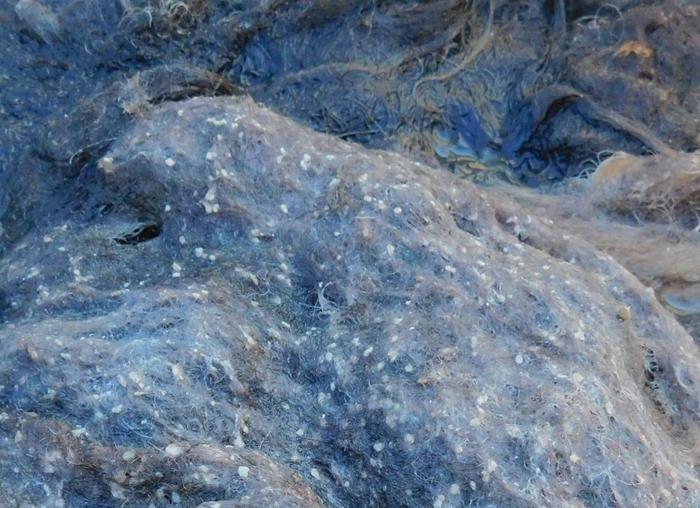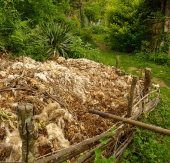

 5
5




How Permies works: https://permies.com/wiki/34193/permies-works-links-threads
My projects on Skye: The tree field, Growing and landracing, perennial polycultures, "Don't dream it - be it! "
 3
3




“Knowledge is knowing a tomato is a fruit: Wisdom is not putting it in a fruit salad. “ Brian Gerald O’Driscoll












 2
2




Sarah Elizabeth wrote:The weather looks great up there in Skye, Nancy. Greetings from Wales.
Sarah Elizabeth wrote:In Ireland they mix dag end fleece with bracken and leave it to compost. It makes really acidic compost which is perfect for blueberries and cranberries and other acid-loving plants. I did this on a very small scale with one fleece at my old house and the plants seemed to like it.
Sarah Elizabeth wrote:A few years ago, the price paid for fleeces here fell below the cost of sheering. Now, I see old fleeces left in fields so maybe the wool board is not buying here either. I will ask my neighbour farmers.
How Permies works: https://permies.com/wiki/34193/permies-works-links-threads
My projects on Skye: The tree field, Growing and landracing, perennial polycultures, "Don't dream it - be it! "










 2
2




Nancy Reading wrote: I think it's been below cost for a while, But they are apparently literally being paid £0 per fleece (The Weavers at least gave them something, and it's local!) I'll have to look again at the feasibility of DIY sheep wool insulation for next year!
“Knowledge is knowing a tomato is a fruit: Wisdom is not putting it in a fruit salad. “ Brian Gerald O’Driscoll
 5
5




Invasive plants are Earth's way of insisting we notice her medicines. Stephen Herrod Buhner
Everyone learns what works by learning what doesn't work. Stephen Herrod Buhner












 3
3




How Permies works: https://permies.com/wiki/34193/permies-works-links-threads
My projects on Skye: The tree field, Growing and landracing, perennial polycultures, "Don't dream it - be it! "
 4
4




There's talk of felting it and using it as batting in quilts over in the fiber arts forum.Nancy Reading wrote:I'm wondering whether to try making some felt? I'm thinking hanging basket liners might be good.
Visit Redhawk's soil series: https://permies.com/wiki/redhawk-soil
How permies.com works: https://permies.com/wiki/34193/permies-works-links-threads












 1
1




Jay Angler wrote:There's talk of felting it and using it as batting in quilts over in the fiber arts forum.
How Permies works: https://permies.com/wiki/34193/permies-works-links-threads
My projects on Skye: The tree field, Growing and landracing, perennial polycultures, "Don't dream it - be it! "












 9
9




How Permies works: https://permies.com/wiki/34193/permies-works-links-threads
My projects on Skye: The tree field, Growing and landracing, perennial polycultures, "Don't dream it - be it! "












 3
3




How Permies works: https://permies.com/wiki/34193/permies-works-links-threads
My projects on Skye: The tree field, Growing and landracing, perennial polycultures, "Don't dream it - be it! "
 1
1




 )
)












 5
5





How Permies works: https://permies.com/wiki/34193/permies-works-links-threads
My projects on Skye: The tree field, Growing and landracing, perennial polycultures, "Don't dream it - be it! "












 4
4




How Permies works: https://permies.com/wiki/34193/permies-works-links-threads
My projects on Skye: The tree field, Growing and landracing, perennial polycultures, "Don't dream it - be it! "




six of one... baker’s dozen of the other
















How Permies works: https://permies.com/wiki/34193/permies-works-links-threads
My projects on Skye: The tree field, Growing and landracing, perennial polycultures, "Don't dream it - be it! "












 7
7




How Permies works: https://permies.com/wiki/34193/permies-works-links-threads
My projects on Skye: The tree field, Growing and landracing, perennial polycultures, "Don't dream it - be it! "












 4
4




How Permies works: https://permies.com/wiki/34193/permies-works-links-threads
My projects on Skye: The tree field, Growing and landracing, perennial polycultures, "Don't dream it - be it! "












 6
6




How Permies works: https://permies.com/wiki/34193/permies-works-links-threads
My projects on Skye: The tree field, Growing and landracing, perennial polycultures, "Don't dream it - be it! "
 3
3




PURPLE CARDS! GET YOUR GARDENING CARDS HERE!! https://www.kickstarter.com/projects/paulwheaton/garden-cards?ref=4qylf3. "The only thing...more expensive than education is ignorance."~Ben Franklin. "We can easily forgive a child who is afraid of the dark; the real tragedy of life is when men are afraid of the light." ~ Plato










 3
3




“Knowledge is knowing a tomato is a fruit: Wisdom is not putting it in a fruit salad. “ Brian Gerald O’Driscoll
 4
4




Brilliant - do the chickens seem to prefer it over other options, or have you ever tested for that? I don't have sheeps' wool, but I've got a big bag of dog fur from my friend's standard poodle.Sarah Elizabeth wrote: We get our organic meat delivery sent to us with sheeps' wool insulation. I currently use it for the chickens' nest boxes ...
Visit Redhawk's soil series: https://permies.com/wiki/redhawk-soil
How permies.com works: https://permies.com/wiki/34193/permies-works-links-threads












 2
2




Sarah Elizabeth wrote:
Is that an antler on the bed in the second picture? For a minute I thought one of your dogs might have been smoking a pipe.
How Permies works: https://permies.com/wiki/34193/permies-works-links-threads
My projects on Skye: The tree field, Growing and landracing, perennial polycultures, "Don't dream it - be it! "










 2
2




Jay Angler wrote: Brilliant - do the chickens seem to prefer it over other options, or have you ever tested for that? I don't have sheeps' wool, but I've got a big bag of dog fur from my friend's standard poodle.
“Knowledge is knowing a tomato is a fruit: Wisdom is not putting it in a fruit salad. “ Brian Gerald O’Driscoll










 3
3




Nancy Reading wrote: It does look a bit like a pipe but yes, it's the nub that's left from Della's "chew antler". It was a full 3 prong antler when she was little and she has worn it down over the last 6 months. They are relatively safe chew toys, they last well, the dogs like them, and being horn rather than bone they don't make hard splinters that the dogs can swallow and hurt themselves with. When they're bigger they can be a bit...prongy for bouncy dogs, but could be cut in half to make them safer if necessary. This one I found up on the hill (the deer shed them every year). I have another really old one spare, but Della hasn't needed that.
Nancy Reading wrote:I saw someone on here (can't find the thread now) that used those wool batts with their chilled delivery to insulate their shed. Good idea since they have moisture barriers on already!
“Knowledge is knowing a tomato is a fruit: Wisdom is not putting it in a fruit salad. “ Brian Gerald O’Driscoll
 5
5




The wool box liner comes in thick sheets and I just cut it to size for each box. They always shred it and make a big loose pile so on the same principle, your bag of poodle fur might work really well. Love to hear how it goes if you try it.
Visit Redhawk's soil series: https://permies.com/wiki/redhawk-soil
How permies.com works: https://permies.com/wiki/34193/permies-works-links-threads
 3
3




Visit Redhawk's soil series: https://permies.com/wiki/redhawk-soil
How permies.com works: https://permies.com/wiki/34193/permies-works-links-threads
 4
4




Visit Redhawk's soil series: https://permies.com/wiki/redhawk-soil
How permies.com works: https://permies.com/wiki/34193/permies-works-links-threads
 4
4




Visit Redhawk's soil series: https://permies.com/wiki/redhawk-soil
How permies.com works: https://permies.com/wiki/34193/permies-works-links-threads










 4
4




Jay Angler wrote:They've made no real effort to incorporate it into a nest which they will do with soft hay, and even the shavings usually end up at least as a ridge with a round gully in the middle.
So the bottom line is - poodle fur doesn't make the cut on my farm! The weird things we learn from chickens!
“Knowledge is knowing a tomato is a fruit: Wisdom is not putting it in a fruit salad. “ Brian Gerald O’Driscoll
 5
5




Visit Redhawk's soil series: https://permies.com/wiki/redhawk-soil
How permies.com works: https://permies.com/wiki/34193/permies-works-links-threads

|
You would be much easier to understand if you took that bucket off of your head. And that goes for the tiny ad too!
The new purple deck of permaculture playing cards
https://www.kickstarter.com/projects/paulwheaton/garden-cards
|







